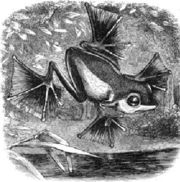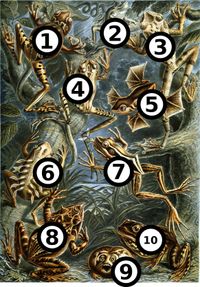Summary
The 68th plate from Ernst Haeckel's 1904 Kunstformen der Natur, depicting frogs classified as Batrachia.
Also consult the labels and text, as well as the translation (remarks made by the translator are in italics or square brackets):
Fig. 1. Notodelphys ovifera (Weinland) now Gastrotheca ovifera (Lichtenstein & Weinland 1854; name revision by Rivero 1961)
The pouch frog of Venezuala is remarkable for its female's possession of a paired dorsal [back] pouch, in which the eggs remain until the hatching of the tadpoles. A narrow triangular gap at the rear of the back (in the centre of the lightly coloured saddle patch) leads to the pouch.
Fig. 2 Hyla meridionalis (Boulenger) authority usually given as (Boettger 1874)
- Hyla meridionalis, Mediterranean Tree Frog, Stripeless Tree Frog.
The treefrog of North Africa and Southern Europe is little different from our native common green treefrog (Hyla arborea) and like the latter lives on trees and shrubs. When crying [calling], the male pushes forward the vocal sac like a bubble.
Fig. 3 Hyla tuberculosa (Boulenger)
The treefrog of Ecuador is characterised by the crude build of its thick fingers (with very wide contact plates) and the knobbly skin, that like in toads is covered in glandular warts.
Fig. 4 Amphignathodon Güntheri (Boulenger) now Gastrotheca guentheri (Boulenger 1882; name revision by Duellman, Maxson & Jesiolowski 1988)
The climbing frog of Ecuador is among the slimmest and most supple forms of treefrogs; his extraordinarily thin and long limbs (with zebralike dark stripes across) enable it of the most dexterous climbing arts.

Alfred Russel Wallace's illustration of the flying frog from
The Malay Archipelago (1869)
Fig. 5 Rhacophorus pardalis (Wallace) authority usually given as (Günther 1858)
The flying frog of Borneo is remarkable above all other Batrachids for its extraordinarily widened foot webbings between the elongated toes. If the flying frog spreads these webs while jumping from tree to tree, he can use them as a parachute, similar to the flying dragon (Draconellus) among the reptiles (Plate 79) and the flying squirrels (Pteromys) among the rodents.
Fig. 6 Hylodes lineatus (Schneider) now Craugastor lineatus (Brocchi 1879)
- Craugastor lineatus
The military frog of Surinam is very peculiar in that the female carries its young on its back in military rank. The little tadpoles, numbering 12 to 20, attach to two diverging back ridges of the mother (that run symmetrically either side of the dorsal central line) by their oral suction plates. The mobile rudder tails are turned outward, on the left side as on the right.
Fig. 7 Limnodytes erythraeus (Duméril) now Rana erythraea (Schlegel 1837)
The banded frog of Java has two parallel white bands on its back, running lengthwise, that contrast strongly against the dark red brown base colour. The jumping treefrog is about to capture an insect with its protruded bicornuated tongue.
Fig. 8 Ceratobatrachus Güntheri (Boulenger)
The tip frog from the Solomon Islands is assigned to the group of "horn frogs" that are distinguished by a pair of sharp horns on top of the triangular head; these are elongated coverings of the upper eye lids. The bright colouration and patterning of this horn frog is most variable and often adapted to its environment.
Fig. 9 Breviceps mossambicus (Peters)
The thickhead frog from East Africa (Mozambique, Sambesi) deviates from all other frogs in the appearance of its very short and thick head. Furthermore, it cannot jump with its short and weak legs, and moves its fat, crude body only with difficulty. The hind feet have large, spade-like digging swellings that help it to rapidly dig itself into the soil. It feeds on termites and in its subterranean habits is equal to the moles.
Fig. 10 Rana pipiens (Linné)
-
Northern Leopard Frog
The pip frog of North America. Right behind the eye, one can see the large white, entirely superficially positioned eardrum.
Detail
Licensing
 |
This image (or other media file) is in the public domain because its copyright has expired.
This applies to the United States, Canada, the European Union and those countries with a copyright term of life of the author plus 70 years.
العربية ǀ Български ǀ Català ǀ Česky ǀ Dansk ǀ Deutsch ǀ English ǀ Ελληνικά ǀ Esperanto ǀ Español ǀ Euskara ǀ فارسی ǀ Français ǀ Galego ǀ עברית ǀ हिन्दी ǀ Bahasa Indonesia ǀ Italiano ǀ 日本語 ǀ 한국어 ǀ Kurdî / كوردي ǀ Nederlands ǀ Norsk (nynorsk) ǀ Bahasa Melayu ǀ Polski ǀ Português ǀ Русский ǀ Slovenščina ǀ Shqip ǀ Suomi ǀ Svenska ǀ Türkçe ǀ 简体中文 ǀ 正體中文 ǀ +/- |
The following pages on the English Wikipedia link to this file (pages on other projects are not listed):






